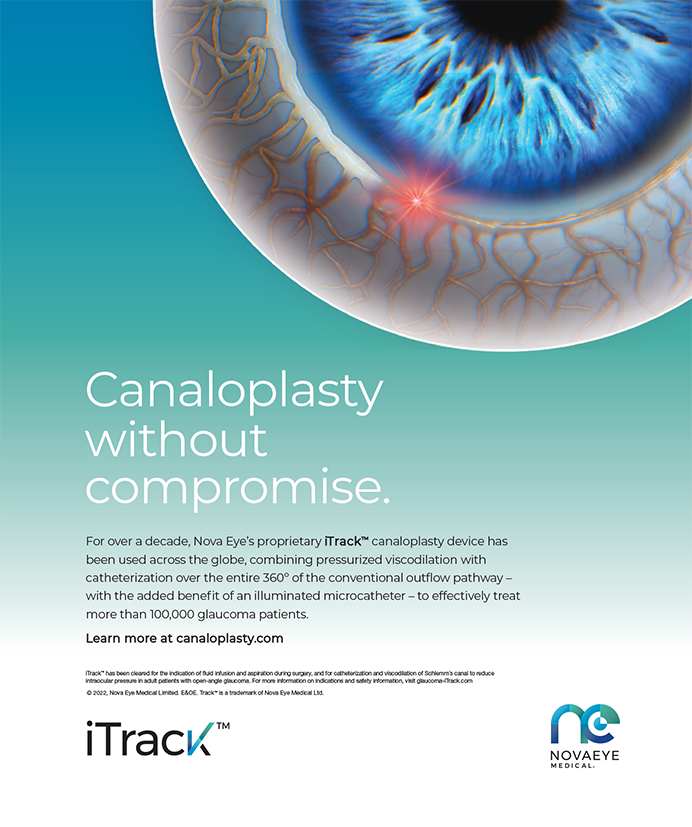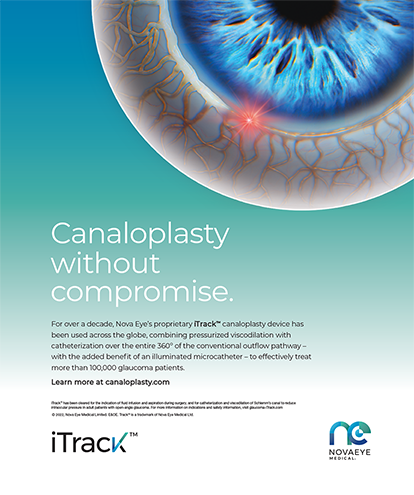Amvisc Plus (Bausch & Lomb, Inc., Rochester, NY) has been my viscoelastic of choice for routine cataract and IOL surgery for many years. Its unique blend of dispersive and cohesive properties makes this ophthalmic viscosurgical device (OVD) ideal for anterior segment surgery. Moreover, the product is readily available and, in my experience, of consistent quality.
PERFORMANCE
The most important roles of an OVD are its protection of ocular tissue and its maintenance of the surgical plane. Amvisc Plus' dispersive properties provide a layer of viscoelastic that protects the cornea, iris, and lens capsule at every stage of the cataract's removal. The OVD's cohesive properties provide generous viscodilation of the pupil during the capsulorhexis. Moreover, Amvisc Plus remains in the chamber during phacoemulsification without impeding nuclear removal.
During phacoemulsification, nuclear fragments present readily to the phaco tip with Amvisc Plus versus with other dispersive OVDs that, in my experience, attract nuclear pieces to the chamber angle on either side of the phaco needle and sleeve. In my hands, cortical cleanup with I/A using balanced salt solution proceeds uneventfully with an adequate layer of Amvisc Plus remaining to protect the corneal endothelium.
OVDs also play a role in the IOL's implantation. Because the excellent clarity of Amvisc Plus allows me to visualize the capsule's surface unhindered, I can use high magnification to help me remove debris from the anterior surface of the posterior capsule. Separation at the tissue plane and smooth, controlled, fluid insertion of the lens implant follow. By creating adequate space and protecting ocular tissue, this OVD enables me to reposition the lens implant as needed. Should anterior or posterior capsular damage occur during cataract surgery, I find Amvisc Plus helpful for positioning the IOL for sulcus fixation and for capturing the IOL's optic behind the intact anterior capsulorhexis.
At the conclusion of surgery, especially with the newer single-piece and accommodating lens implants, it is mandatory to remove the OVD from the anterior segment, including the viscoelestic behind the lens implant and in front of the posterior capsule. Any remaining cortical debris will tend to increase postoperative inflammation and the probability of IOP spikes. Both the cortex and surface debris should be removed, and they most certainly will be with the thorough evacuation of the OVD. I find the removal of Amvisc Plus to be efficient versus the laborious and time-consuming process I have encountered with some dispersive viscoelastics. Also, occasional small, but significant, nuclear fragments are hidden in the posterior chamber or anterior chamber angle. When using dispersive OVDs, the surgeon must take extra time to look for and remove these fragments. I find that the cohesive nature of Amvisc Plus brings nuclear fragments together as I remove the OVD from the chamber.
EVALUATION
In 2007, I reported the results of my direct comparison of Amvisc Plus and DisCoVisc (Alcon Laboratories, Inc., Fort Worth, TX).1 There were 10 eyes in each OVD group. I performed the cataract procedure using the Stellaris Vision Enhancement System (Bausch & Lomb, Inc.), coaxial phacoemulsification, and microincisional instrumentation.
The procedure was uneventful in the Amvisc Plus eyes. In the DisCoVisc eyes, however, I had difficulty initiating nucleofractis due to poor aspiration when I attempted to clear the OVD before engaging the nuclear surfaces. Increased vacuum levels were required. Moreover, because nuclear fragments became lodged in the DisCoVisc located in the anterior chamber angle, additional manipulation and time were required to remove the residual nuclear material. After implanting the IOL, the OVD's removal was easier and faster with Amvisc Plus than DisCoVisc, probably due to its greater dispersive tendency. I found cortical removal and the IOL's insertion to be equivalent with the two OVDs (Figure 1).
CONCLUSION
For me, the smooth nuclear emulsification and the surety of the OVD's complete removal at the end of the procedure are critical for a safe cataract surgery. Thus, Amvisc Plus is my viscoelastic of choice for routine cataract procedures.
John D. Hunkeler, MD, is the founder of the Hunkeler Eye Institute in Kansas City, Missouri, and a clinical professor with the Department of Ophthalmology at the University of Kansas School of Medicine in Kansas City. He is a consultant to Abbott Medical Optics Inc. and Bausch & Lomb, Inc. Dr. Hunkeler may be reached at (913) 338-4733; jhunkeler@hunkeler.com.
- Hunkeler JD. Assessment of 2 OVDs for use in cataract surgery: Amvisc Plus versus DisCoVisc. Paper presented at: The ASCRS Symposium on Cataract, IOL and Refractive Surgery; May 1, 2007; San Diego, CA.


